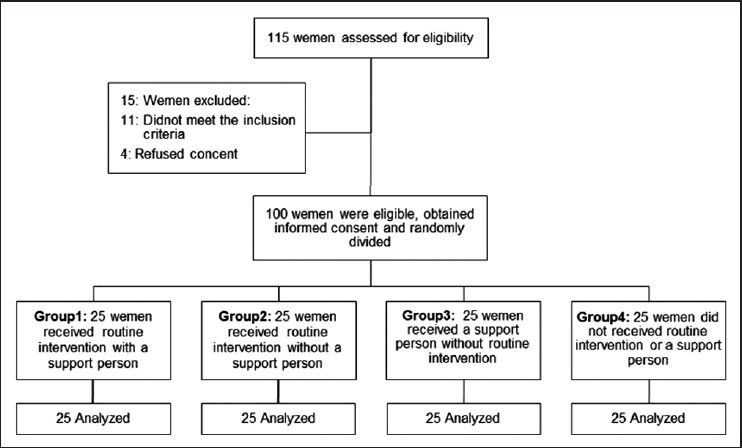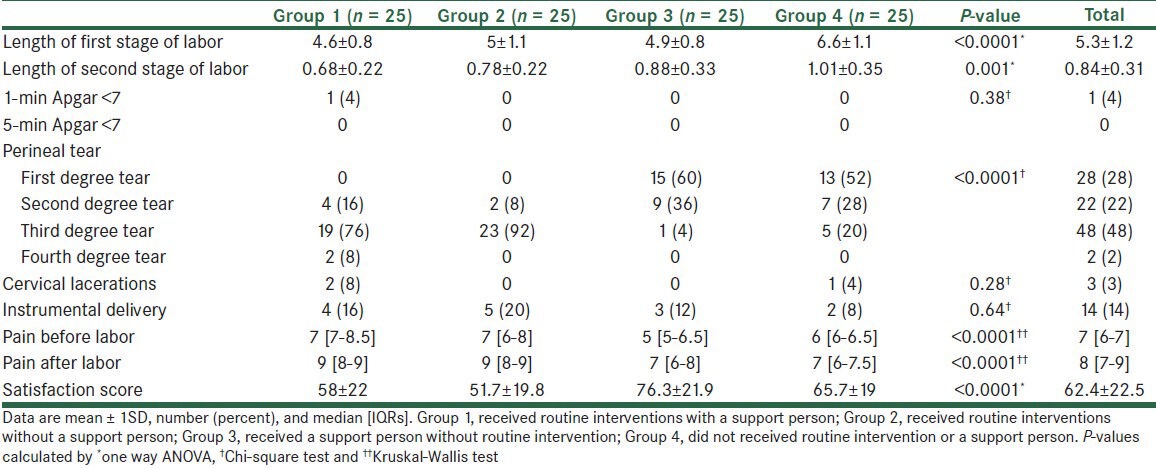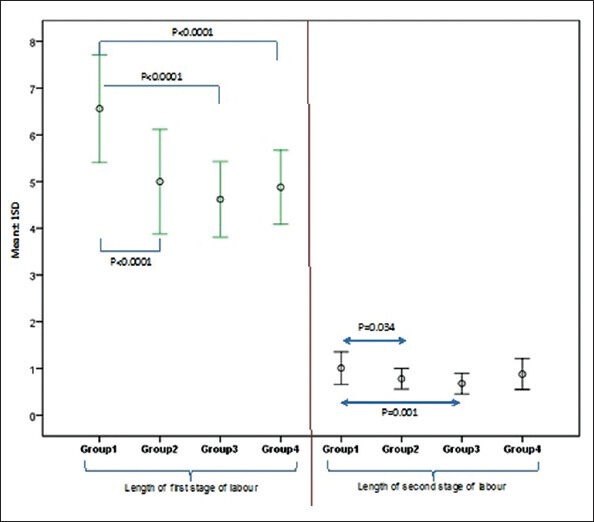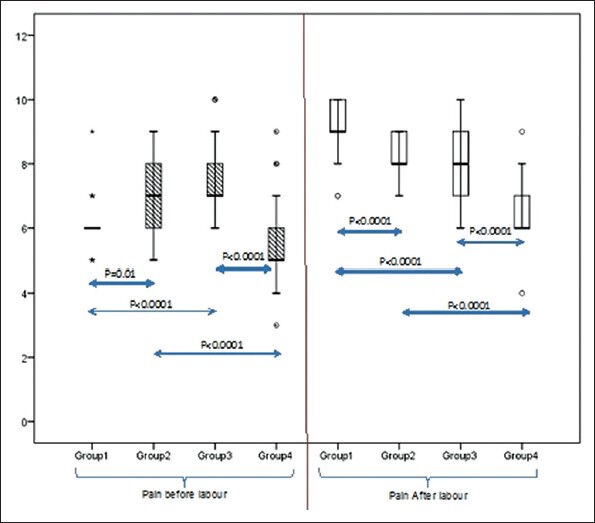Abstract
Background:
The aim of this study was to examine the effects of the presence of continuous support person and routine interventions during labor and delivery in Isfahan, Iran.
Materials and Methods:
One hundred pregnant women in spontaneous labor were assessed in four groups: Group 1; received routine intervention with a support person, Group 2; received routine intervention without support person, Group 3; received support person without routine intervention, Group 4; did not receive routine intervention or a support person. Sociodemographic, antenatal characteristics, length of stage of labor, instrumental delivery, the cervical laceration, perineal tear, labor pain, satisfaction and Apgar score collected and analyzed.
Results:
Based on the results there was no significant difference in regard to maternal age, BMI, maternal education and working statutes among the studied groups (P-value >0.05). Also, 1 and 5-min Apgar <7, cervical lacerations and instrumental delivery among studied groups were similar (P-value >0.05). Length of first and second stage of labor, perineal tear, satisfaction score and pain before and after labor were significant among studied groups (P-value <0.05).
Conclusions:
Presence of a support person and routine intervention during labor did not effect on incidence of cervical lacerations, instrumental delivery and Apgar <7. Labor pain and women's dissatisfaction, and number women with third and fourth degree of perineal tear among women who received routine intervention were increased compare to others. Interventions makes decreased the length of first and second stage of labor. In totally, the presence of a support person during labor in Iranian women decrease length of labor and improved labor outcomes.
Keywords: Cervical lacerations, childbirth, instrumental delivery, labour, perineal tear
INTRODUCTION
One of the most stressful events in a woman's life is childbirth; therefore, the elimination of negative elements associated with labor and delivery is an important care,[1] Research has revealed that maternal anxiety for the duration of childbirth will be decreased, when women in labor have a better sense of control,[2,3] which finally leads to a more positive birth experience.[4] Though the meaning of control during labor among women is varies.[5,6] The role of continuous support during labor[7] and prenatal education by healthcare experts,[7,8,9,10,11] recently, has been clearly defined as handling policies for childbirth. Labor support from a birth companion is a major step towards greater personal control, which has been found beneficial in reducing maternal distress.[12,13,14] One study showed that birth companions help women to feel in control during labor, whereas, for women who are alone, labor is a long and exhausting effort, full of uncertainties.[15] Hodnett et al. in a systematic review in 2011 evaluated all published and unpublished randomized controlled trials comparing continuous support during labor with usual care and concluded that continuous support during labor has clinically meaningful benefits for women and infants with no known harm and suggested that women should have support during labor and birth.[14] It is recommended by WHO that a parturient woman can be allowed to have a birth companion she trusts and with whom she feels at comfort.[15] However, in many developing countries, WHO recommendations do not tend to be followed.
The main social support persons, in many high-income countries like the USA (since the 1970s) and the UK, include close relatives,[16,17,18] husbands/partners.[19] and doulas.[20,21] Female relatives or friends attend to women's comfort during labor in parts of Latin America, Mexico and Africa.[22,23] In the other hand, at least until 2005 in many Russian hospitals, husbands, partners, and other support companions are not allowed in the delivery room.[8] Companionship during childbirth also is not routine practice in many less-industrialized countries, like Nigeria.[1] In randomized trials showed that women who are supported during labor (by a female relative, husband, a doula or another social support person),[16,17,18,19,20,21] reported less anxiety, need fewer medical interventions and have fewer complications. In addition, it is concluded that women value companionship and support during labor.[24,25]
In all cultures, childbirth is considered a period of great vulnerability for a woman, and support systems are an essential component of the birthing experience. In Iran like many other developing countries, companionship during childbirth is not routine practice, also given the wide range of cultural and societal differences in childbirth practice in Iran and there is no study to assess effects of the presence of support person during labor in Iranian women. Therefore, the present study was designed to examine the effects of the presence of continuous support person (mother, sister, female close relative or female friends) with or without routine interventions during labor and delivery in Isfahan, Iran.
MATERIALS AND METHODS
Between Jul, 2011, and Apr, 2012, in a double-blind randomized controlled trial, 100 pregnant women in spontaneous labor who referred and hospitalized in Shahid Beheshti hospital, Isfahan, Iran, enrolled and studied. The main objective of this study was to assess the effect of the presence of a companion as a support person during labor. Patients aged between 18 and 35 years were eligible, if they had a singleton normal full-term pregnancy and patient desire to have natural vaginal delivery, 38 to 42 weeks of gestation, spontaneous onset of labor and normal birth with no special procedures or consultation who had delivered a singleton infant with no history of obstetric, medical or psychological problems. Also, women were eligible if their family or a female friend was available to stay in the hospital throughout the birth process. Exclusion criteria included women, who had chosen to have a caesarean section, and had cervical dilatation of more than four centimeters at the time of admission or were having induction and augmentation. The study was approved in Isfahan University of Medical Sciences for quality of design and ethical integrity and was reviewed annually. All women voluntarily consented to take part in the study and written informed consent was obtained from all of them.
Patients meeting the eligibility criteria were selected in a simple non-random manner and randomly divided into four 25-member groups. Group 1 included women who received routine intervention with a support person. Group 2 included women who received routine intervention without support person. Group 3 included women who received support person without routine intervention. Group 4 included women who did not receive routine intervention or a support person. Additionally, all patients in four study groups received routine care, included: Monitoring of uterine contractions, bleeding, fetal medicals care and other usual hospitals’ medical cares. Also, patients entered to the study were held in reserve in private room to keep the privacy of patient and her support.
At the beginning of the study, patients and support persons were informed about labor process. And the support persons were guided, to support the laboring woman and were careful to take their role. A support person was defined as a “non-member of the health team in care of the patient in labor, who is close to the person, such as mother, sister, or friend, who the patient wants present with her in the delivery room. The role of the support person in labor includes provision of continuous presence, reassurance and praise, comforting touch, massage, warm baths/showers, and overall continuous labor support from their birth partner until the end of the first stage, and continued to receive help throughout the second stages of labor.
Each woman after the birth of her baby was contacted in the postnatal unit and interviewed by the research assistant to collect the data. Data collection included the sociodemographic, and antenatal characteristics of the women plus length (min) of first and second stage of labor, Instrumental delivery, the cervical laceration (yes/no), perineal tear (into four categories), pain before and after labor using the numeric rating scale, between 0 (no pain) and 10 (worst pain). Satisfied with labor experience using the numeric rating scale (between 0 and 100) and Apgar score less than seven at 1 and 5 min score.
Perineal tears are classified into four categories: First degree tear: Laceration is limited to the fourchette and superficial perineal skin or vaginal mucosa, second degree tear: Laceration extends beyond fourchette, perineal skin and vaginal mucosa to perineal muscles and fascia, but not the anal sphincter, third degree tear: Fourchette, perineal skin, vaginal mucosa, muscles, and anal sphincter are torn, and fourth degree tear: Fourchette, perineal skin, vaginal mucosa, muscles, anal sphincter, and rectal mucosa are torn.
Data were analyzed using SPSS-20 software. Variables were presented as mean ± SD, number (percent) and median [IQR]. Age, BMI, length of first and second stage of labor and satisfaction compared among study groups by ANOVA. Pain score compared among study groups by Kruskal walls test and groups were compared two by two using Mann-Whitney test. In addition, Chi-square test was used to assess the maternal education, working statues, Apgar less than seven, perineal tear, presence of cervical laceration and Instrumental delivery among study groups. Statistical significance was accepted at P-value lower than 0.05.
RESULTS
Figure 1 shows the flowchart of study. Of 115 women who assessed for eligibility, 15 women excluded; 11 did not meet the inclusion criteria and 4 women refused informed consent. Finally, 100 women inter the study, randomly divided to the study group, completed the study and analyzed.
Figure 1.

Flowchart of trial
Total mean maternal age of the studied women was 26.1 ± 4.3 years. Moreover, these patients had the mean BMI of 21.8 ± 2.1 kg, maternal education in 47% of women was upper than high school and 53% of them were educated lower than high school, also 83% of women were house keeper. In Table 1, age, BMI, maternal education and working statutes of the participants are compared to one another among the studied groups, based on the results of which there was no statistically significant difference in regard to these variables among the studied groups (P-value > 0.05).
Table 1.
Comparison of age, education, job and BMI in 100 women in study groups

Table 2 shows the comparison of characteristics among studied groups. As shown in Table 1 and 5-min Apgar < 7, cervical lacerations and instrumental delivery among studied groups were similar (P-value > 0.05). Perineal tear, satisfaction score and pain before and after labor were statistically significant among studied groups (P-value < 0.05). Women with only support person had higher satisfaction score, whereas women who received routine interventions reported lowest satisfaction score compare to other woman. Length of first and second stage of labor in women who received routine interventions with a support person during labor was lower than other studied groups (P-value > 0.01). Based on the results of post hoc test, which presented in Figure 2, length of first stage of labor was statistically significant between Group 1 and 2 (P-value > 0.0001), Group 1 and 3 (P-value > 0.0001) and Group 1 and 4 (P-value > 0.0001). Also, length of second stage of labor was statistically significant between Group 1 and 2 (P-value = 0.034), Group 1 and 3 (P-value = 0.001). To compare pain before and after labor between groups two by two, Mann-Whitney test was used and significant differences was found between Group 1 and 2 (P-value = 0.01), Group 1 and 3 (P-value > 0.0001), Group 1 and 4 (P-value > 0.0001) and Group 3 and 4 (P-value > 0.0001) for pain before labor. Pain after labor was statistically significant between Group 1 and 2 (P-value > 0.0001), Group 1 and 3 (P-value > 0.0001), Group 2 and 4 (P-value > 0.0001) and Group 3 and 4 (P-value > 0.0001) was statistically significant [Figure 3].
Table 2.
Comparison of characteristics in studied population

Figure 2.

Comparison of length of first and second stage of labor between groups two by two, using Post Hoc test (Bonferroni) in 100 studied women. Group 1, received routine interventions with a support person; Group 2, received routine interventions without a support person; Group 3, received a support person without routine intervention; Group 4, did not received routine intervention or a support person
Figure 3.

Comparison of pain before and after labor between groups two by two, using Mann-Whitney test in 100 studied women. Group 1, received routine interventions with a support person; Group 2, received routine interventions without a support person; Group 3, received a support person without routine intervention; Group 4, did not received routine intervention or a support person
DISCUSSION
An integral part of childbirth is birth attendants. In most countries, midwife or physician as a specialized medical attendant is present at every birth. In many countries, a support person may also be present. Husbands, partners, and close relatives are the main external support participants during labor and delivery in developed countries.[16,17,18] In Iran, presence of support person during labor and delivery is not routine, whereas, benefits of comparing continuous support during labor for women and infants are showed in proviruses studies.[14] Also, because of Iranian women's custom, that they prefer to be supported by other women rather than their husbands, the results of the present study, with the aim of investigating the effects of the presence of mother, sister, female close relative or female friends as a support person during labor in Iranian women was done and revealed that in women with support person incidence of cervical lacerations and instrumental delivery and Apgar <7 was similar to other women. The length of first and second stage of labor in women with support person and routine intervention was lower than women on other groups. Also, women with support person without routine intervention reported low pain before and after labor compare to others and they were more satisfied. Women who received routine intervention with or without support person showed higher pain score before and after labor, higher incidence of perineal tear and were more dissatisfied compare to women who did not received routine intervention with or without support person. In totally, our results showed that presence of support person during labor have good effect on outcomes in pregnant women during labor and delivery.
Our results regarding the decrease in duration of the first stage of labor are similar to data reported from studies in which support was provided by midwives,[26] or other support persons[7,14] where it was reduced. These results are contradictory to data from Bruggemann et al.[27] that reported no significant differences between women with support person compare to women without support person.
In agreement with Sapkota et al.[28] study (among Nepalese women), Green et al. study[13] (among English women) and Christianes et al. study[29] (among Dutch women) which reported lower labor pain in women with support compare to controls group, present study (among Iranian women) found that women with support person without routine intervention had low labor pain compare to other women. Also, Hodnett et al.[14] reviewed randomized controlled trials in 2011 and displayed the effect of the presence of support person during labor on labor pain relief. These results support the presence of support person during labor, as the authors of a systematic review[14] emphasize that; women can feel good about her behavior during labor when the companion provide physical support to help the woman tolerate the intensity of the contractions. Therefore, through birth preparation classes, there should be an emphasis on the acquisition of skills for anyone who supports a woman in labor.
Satisfaction may have been influenced by social ability and/or fear of reprisals, or because of a sensation of relief at having gone through a safe experience and having a healthy baby.[30] Though, this effect would possibly be the equal for groups and could not explain the difference between them. In agreement with other studies,[14,26,30,31] in present study, presence of support person during labor increase satisfies in studied women. However, in our study women with support person without any routine intervention were high satisfaction whereas, women with support person who received routine intervention were more dissatisfied compare to other women and it showed that routine intervention makes women more dissatisfied.
Although, results of this study showed advantage of the presence of support person during labor in Iranian women, there were some limitations to the study. Firstly, results of this study gained from women giving birth to their first child, and we should be careful about generalizing these findings to women who experienced giving birth to a second, or more child. Another limitation of the study is that we did not assess qualitatively the attitudes and opinions of Iranian women regarding the presence of support person during labor also because of the wide range of cultural and societal differences in Iran; large multicenter studies is required to be done to investigate opinions, traditional beliefs, attitudes, practices among Iranian women and also the attitudes of support person need to be explored.
In conclusion, the results of this study showed that presence of a support person and routine intervention during labor among studied women did not effect on incidence of cervical lacerations, instrumental delivery and Apgar < 7 and was similar to other women who did not received routine intervention or support person. Labor pain and women's dissatisfaction among women who received routine intervention were increased compare to women without routine intervention, but these interventions makes decreased the length of first and second stage of labor. Also, the number women with third and fourth degree of perineal tear increased in women who received routine intervention, whereas, most of women without routine intervention have shown first and second degree of perineal tear. Overall, the presence of a support person during labor and delivery in Iranian women decrease length of labor and improved labor outcomes however, further studies are need to be done.
Footnotes
Source of Support: Royan Institute and Iranian Council of Stem Cell Technology
Conflict of Interest: None declared.
REFERENCES
- 1.Oboro VO, Oyeniran AO, Akinola SE, Isawumi AI. Attitudes of Nigerian women toward the presence of their husband or partner as a support person during labor. Int J Gynaecol Obstet. 2011;112:56–8. doi: 10.1016/j.ijgo.2010.07.033. [DOI] [PubMed] [Google Scholar]
- 2.Shahshahan Z, Hashemi M. Crown-rump length discordance in twins in the first trimester and its correlation with perinatal complications. J Res Med Sci. 2011;16:1224–7. [PMC free article] [PubMed] [Google Scholar]
- 3.Chunuan S, Somsap Y, Pinjaroen S, Thitimapong S, Nangham S, Ongpalanupat F. Effect of the presence of family members, during the first stage of labor, on childbirth Outcomes in a Province Hospital in Songkhla Province, Thailand. Thai J Nurs Res. 2009;13:16–27. [Google Scholar]
- 4.Campero L, Garcia C, Diaz C, Ortiz O, Reynoso S, Langer A. “Alone, I wouldn’t haveknown what to do”: A qualitative study on social support during labor and delivery in Mexico. Soc Sci Med. 1998;47:395–403. doi: 10.1016/s0277-9536(98)00077-x. [DOI] [PubMed] [Google Scholar]
- 5.Green JM, Baston HA. Feeling in control during labour: Concepts, correlates and consequences. Birth. 2003;30:235–47. doi: 10.1046/j.1523-536x.2003.00253.x. [DOI] [PubMed] [Google Scholar]
- 6.Namey EE, Drapkin LA. The meaning of control for childbearing women in the US. Soc Sci Med. 2010;71:769–76. doi: 10.1016/j.socscimed.2010.05.024. [DOI] [PMC free article] [PubMed] [Google Scholar]
- 7.Hodnett ED, Gates S, Hofmeyr GJ, Sakala C. Continuous support for women during childbirth. Cochrane Database Syst Rev. 2007:CD003766. doi: 10.1002/14651858.CD003766.pub2. [DOI] [PubMed] [Google Scholar]
- 8.Bakhta Y, Lee RH. A survey of Russian women regarding the presence of a companion during labor. Int J Gynecol Obstet. 2010;109:201–3. doi: 10.1016/j.ijgo.2010.01.021. [DOI] [PubMed] [Google Scholar]
- 9.Brailey S. A Swiss birthing centre. Pract Midwife. 2008;11:27–8. [PubMed] [Google Scholar]
- 10.Kaz´mierczak W, Fiegler P, Wegrzyn P, Cholewa D. The role of a family delivery in the modern obstetrics. Wiad Lek. 2006;59:317–20. [PubMed] [Google Scholar]
- 11.Buck L. On labor support and doulas. AWHONN Lifelines. 2006;10:279. doi: 10.1111/j.1552-6356.2006.00057.x. [DOI] [PubMed] [Google Scholar]
- 12.Chunuan S, Somsap Y, Pinjaroen S, Thitimapong S, Nangham S, Ongpalanupat F. Effect of the presence of family members, during the first stage of labor, on childbirth Outcomes in a Province Hospital in Songkhla Province, Thailand. Thai J Nurs Res. 2009;13:16–27. [Google Scholar]
- 13.Green JM, Baston HA. Feeling in control during labour: Concepts, correlates and consequences. Birth. 2003;30:235–47. doi: 10.1046/j.1523-536x.2003.00253.x. [DOI] [PubMed] [Google Scholar]
- 14.Hodnett ED, Gates S, Hofmeyr GJ, Sakala C, Weston J. Continuous support for women during childbirth. Cochrane Database Syst Rev. 2011;2:CD003766. doi: 10.1002/14651858.CD003766.pub3. [DOI] [PubMed] [Google Scholar]
- 15.Campero L, García C, Díaz C, Ortiz O, Reynoso S, Langer A. “Alone, I wouldn’t have known what to do”: A qualitative study on social support during labor and delivery in Mexico. Soc Sci Med. 1998;47:395–403. doi: 10.1016/s0277-9536(98)00077-x. [DOI] [PubMed] [Google Scholar]
- 16.World Health Organization. Geneva: WHO Press; 2009. Integrated management of pregnancy and childbirth. WHO recommended interventions for improving maternal and newborn health. [Google Scholar]
- 17.Campbell D, Scott KD, Klaus MH, Falk M. Female relatives or friends trained as labor doulas: Outcomes at 6 to 8 weeks postpartum. Birth. 2007;34:220–7. doi: 10.1111/j.1523-536X.2007.00174.x. [DOI] [PubMed] [Google Scholar]
- 18.Kuczkowski KM. Female companionship during labor: A crucial resource in times of stress. J Midwifery Womens Health. 2004;49:552. doi: 10.1016/j.jmwh.2004.08.004. [DOI] [PubMed] [Google Scholar]
- 19.Pascali Bonaro D, Kroeger M. Continuous female companionship during childbirth: A crucial resource in times of stress or calm. J Midwifery Womens Health. 2004;49(4 Suppl 1):19–27. doi: 10.1016/j.jmwh.2004.04.017. [DOI] [PubMed] [Google Scholar]
- 20.Swiatkowska-Freund M, Kawiak D, Preis K. Advantages of father's assistance at the delivery. Ginekol Pol. 2007;78:476–8. [PubMed] [Google Scholar]
- 21.Berg M, Terstad A. Swedish women's experiences of doula support during childbirth. Midwifery. 2006;22:330–8. doi: 10.1016/j.midw.2005.09.006. [DOI] [PubMed] [Google Scholar]
- 22.Campbell DA, Lake MF, Falk M, Backstrand JR. A randomized control trial of continuous support in labor by a lay doula. J Obstet Gynecol Neonatal Nurs. 2006;35:456–64. doi: 10.1111/j.1552-6909.2006.00067.x. [DOI] [PubMed] [Google Scholar]
- 23.Maimbolwa MC, Sikazwe N, Yamba B, Diwan V, Ransjö Arvidson AB. Views on involving a social support person during labor in Zambian maternities. J Midwifery Womens Health. 2001;46:226–34. doi: 10.1016/s1526-9523(01)00134-9. [DOI] [PubMed] [Google Scholar]
- 24.Madi BC, Sandall J, Bennett R, MacLeod C. Effects of female relative support in labor: A randomized controlled trial. Birth. 1999;26:4–8. doi: 10.1046/j.1523-536x.1999.00004.x. [DOI] [PubMed] [Google Scholar]
- 25.Price S, Noseworthy J, Thornton J. Women's experience with social presence during childbirth. MCN Am J Matern Child Nurs. 2007;32:184–91. doi: 10.1097/01.NMC.0000269569.94561.7c. [DOI] [PubMed] [Google Scholar]
- 26.Modarres Nejad V. Couples’ attitudes to the husband's presence in the delivery room during childbirth. East Mediterr Health J. 2005;11:828–34. [PubMed] [Google Scholar]
- 27.Kashanian M, Javadi F, Haghighi MM. Effect of continuous support during labor on duration of labor and rate of cesarean delivery. Int J Gynaecol Obstet. 2010;109:198–200. doi: 10.1016/j.ijgo.2009.11.028. [DOI] [PubMed] [Google Scholar]
- 28.Bruggemann OM, Parpinelli MA, Osis MJ, Cecatti JG, Neto AS. Support to woman by a companion of her choice during childbirth: A randomized controlled trial. Reprod Health. 2007;4:5. doi: 10.1186/1742-4755-4-5. [DOI] [PMC free article] [PubMed] [Google Scholar]
- 29.Sapkota S, Kobayashi T, Kakehashi M, Baral G, Yoshida I. In the Nepalese context, can a husband's attendance during childbirth help his wife feel more in control of labour? BMC Pregnancy Childbirth. 2012;12:49. doi: 10.1186/1471-2393-12-49. [DOI] [PMC free article] [PubMed] [Google Scholar]
- 30.Christiaens W, Verhaeghe M, Bracke P. Pain acceptance and personal control in pain relief in two maternity care models: A cross-national comparison of Belgium and the Netherlands. BMC Health Serv Res. 2010;10:268–79. doi: 10.1186/1472-6963-10-268. [DOI] [PMC free article] [PubMed] [Google Scholar]
- 31.Hodnett ED. Pain and women's satisfaction with the experience of childbirth: A systematic review. Am J Obstet Gynecol. 2002;186:S160–72. doi: 10.1067/mob.2002.121141. [DOI] [PubMed] [Google Scholar]


